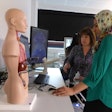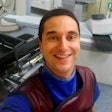
Generation Y, born between 1981 and 2000, has been called the copy-and-paste generation who are "living while working."1 Some observers even think vocation in medicine is being replaced by an engagement in the health system as a means of obtaining a not-too-burdensome livelihood. What's the truth about young doctors?
I must start here with a disclaimer: Don't shoot the messenger. I only relay what I was told and what I have read and have observed.
Early in the new year I wrote a column about smartphones and the change of doctors' bedside manners. The feedback for the column was considerable. For many people, the little black machines (LBMs) in the hands of younger colleagues seemed to be a bone of contention, but they didn't dare voice this in public. Still, they were aware that some of their younger colleagues become so engrossed in their LBM that they neglect their tasks -- and, where face-to-face patient or general human relations are concerned, many of the LBM users are at a loss.
 Dr. Peter Rinck, PhD, is a professor of diagnostic imaging and the president of the Council of the Round Table Foundation (TRTF) and European Magnetic Resonance Forum (EMRF).
Dr. Peter Rinck, PhD, is a professor of diagnostic imaging and the president of the Council of the Round Table Foundation (TRTF) and European Magnetic Resonance Forum (EMRF).
Then, for four or five months, there was a trickle of more comments and footnotes during conversations. Taken together, they widened the topic. The LBM obsession was seen as only one symptom of the changes in the social dynamics of healthcare systems, be it in hospitals or private offices.
Hospital life and teamwork reflect a change in traditions. Bedside manners must adjust to new attitudes, as must the entire social interaction among colleagues and hospital administrators -- and attitudes toward patients. Never forget that patients should come first, not administrators.
A new generation of radiologists has arrived and started climbing the career ladder. While watching them, everyone hopes that they would have learned from the successes and mistakes of the past. They have, but not like we imagined. Things turned out differently. Reality is a poor match for dreams.
I have followed the topic of social and organizational dynamics for some time. It is multilayered and rather complex. It boils down to three main points that go hand in hand. First, there is a new generation moving into all medical disciplines. Second, there are fewer highly qualified doctors than our European and North American societies need in order to maintain the existing health system, and this is not limited to medical imaging.2 Third, there will be a majority of female doctors.3
Today's younger working generation is known as "Generation Y;" the Y doesn't stand for young, but Y follows after X in the alphabet, and the sequel is Generation Z. Generation X (born between 1965 and 1980) replaced the first generation after World War II, the baby boomers (1946-1964). The baby boomers grew up and lived to work and replace what had been destroyed and lost during the war. Generation X worked "to live and have fun" and is consequently called "Spass-Generation" ("fun generation") in German.
During the last two years one has started stumbling across articles on Generation Y in the professional journals of many medical disciplines -- surgery; ear, nose, and throat; anesthesiology; general practice; even hospital administration -- from Australia to Canada to the U.K. To date, I haven't found any discussion in radiological journals. The journal articles are mostly balanced, trying to describe the arising situation and pinpointing possible adaptations of the health system.
The only ones being prepared to cope with the emerging development seem to be the marketing departments of the radiological manufacturers and a number of congress organizers; they respond to and try to exploit the new characteristics and traits to sell to the younger doctors.
The transition from one generation to the next has never been easy. The combination of an independent young generation that grew up in comfort and affluence, pampered and overprotected by their parents, exposed to the digital revolution in a period when the quality of school and university education declined, is seen by many sociologists and psychologists as a possible threat to the existing stable society and workplace structures.
The authors of most articles agree on several points: Vocation in medicine is being replaced by an engagement in the health system as a means of a not-too-burdensome livelihood. The young doctors appreciate competence, but want flat organizations. The hierarchies of the baby boomers (and Generation X) are no longer accepted. On the other hand, baby boomers generally view Generation X physicians as less committed to their medical careers.4 The standing of Generation Y will be even worse.
The two older generations engaged in the workforce have a routine grasp on new technologies, but they prefer books and can read and digest longer treatises. Generation X slowly unlearned arithmetic and orthography. Generation Y -- people fear -- outsource their cerebral activities to their LBMs. Generation Y uses all kinds of digital devices permanently, but the absolute majority consists of passive users, not active ones. They prefer short, easily written texts, if possible on screen. They play with apps, but cannot create websites on their own. They lack analytical thinking and do not understand how technologies and, for instance, sophisticated medical imaging techniques such as MRI, ultrasound, and molecular imaging compounds function. They are consumers.
Because there is a lack of physicians in many countries, their bargaining position is excellent. They know their value and don't sell themselves short. The employers have to fill the openings somehow, thus they have to compromise.
The German surgeon Christian Schmidt put it bluntly: "Employers cannot ignore the needs, desires, and attitudes of this vast generation."1 Or put even more brutally, times have changed. The heads of departments or hospital administrations cannot terrorize the residents any more -- no more 36-hour shifts. Nowadays the residents have the say. They say: kindergarten, parental leave, flexible work hours, additional unpaid holidays, no overtime, or if overtime, cash on hand. Generation Y doctors are not afraid to question authority, or to abruptly quit their job. The older generations describe this as lack of loyalty, the younger ones talk about "reorientation," looking for "new challenges." However, they don't like stress. If they cannot stand their superiors or their work environment, they don't try to adapt but leave: "I don't have to put up with this."
According to Schmidt and his co-authors, many hospitals already need 2.5 positions for what used to be done by one physician some years ago. However, there are already 12,000 open positions in Germany alone. The fight between different employers will become fierce. In this context, the German author makes a quite harsh statement: "The quality of training appears to be the critical factor in a clinic's recruiting process. At the same time, the suitability of candidates is decreasing."2,5 Pragmatic and unpleasant solutions in the health system with a negative impact on future patients will follow.
One should never tar an entire group -- in this case Generation Y -- with the same brush. However, most arguments and observations are repeated in conversations and in articles from several countries. The consequences and implications of these changes are not foreseeable yet.
The normal reaction in such situation is to look for somebody to blame: "Let's put the blame on Generation Y." However, it's not their fault. They grew up in an environment whose rules they followed; it's not their fault that values and education declined, it is an evolutionary process they were born into.
I will take up the topic again in some weeks.
References
- Schmidt CE, Möller J, Schmidt K, et al. Generation Y: Recruitment, retention, and development. Anaesthesist. 2011;60(6):517-524 [in German; abstract in English].
- Schmidt K, Meyer JE, Liebeneiner J, Schmidt CE, Hüttenbrink KB. The shortage of qualified staff in Germany: A survey on head physicians' expectations of young doctors. HNO. 2012;60:102-108 [in German; abstract in English].
- Rinck PA. Why 'feminization' of radiology is good news for patients. 20 June 2011. http://www.auntminnieeurope.com/index.aspx?sec=nws&sub=rad&pag=dis&ItemID=605210
- Jovic E, Wallace JE, Lemaire J. The generation and gender shifts in medicine: An exploratory survey of internal medicine physicians. BMC Health Serv Res. 2006;6:55.
- Schlitzkus LL, Schenarts KD, Schenarts PJ. Is your residency program ready for Generation Y? J Surg Educ. 2010;67(2):108-111.
Dr. Peter Rinck, PhD, is a professor of diagnostic imaging and the president of the Council of the Round Table Foundation (TRTF) and European Magnetic Resonance Forum (EMRF).
The comments and observations expressed herein do not necessarily reflect the opinions of AuntMinnieEurope.com, nor should they be construed as an endorsement or admonishment of any particular vendor, analyst, industry consultant, or consulting group.
















